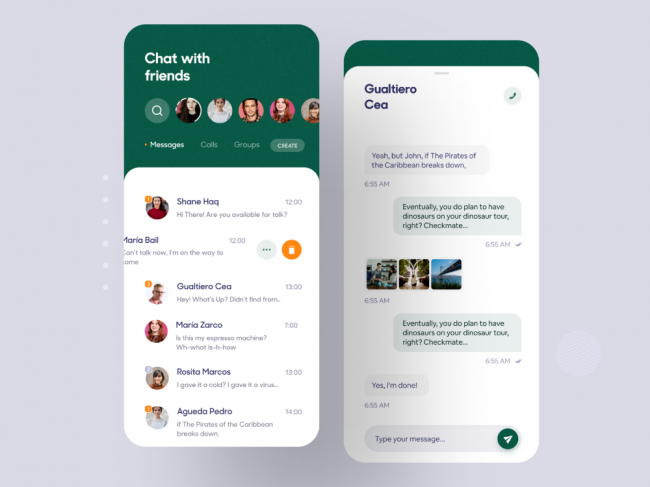UX design principles are important for messaging apps because they directly impact user satisfaction and interaction. For example, consider WhatsApp – its simplicity in design enhances usability. You can take the example of this popular messaging app and can make app like WhatsApp.
The principle of simplicity makes sure that users can navigate the app effortlessly, find features quickly, and send messages without confusion. Also, prioritizing clarity in messaging ensures that the users understand how to compose and read messages easily, leading to efficient communication.
In this content, you will learn the foremost essential UX design principles to make your messaging mobile app more convenient and easier to use for the users.
Simplified Onboarding Process
The first impression always matters, especially in the app development world. An organized onboarding process is essential for guiding your users through the features and functionalities of your app. Instead of bombarding them with lengthy tutorials, you should go for a minimalist approach that highlights the key features of your app.
Use intuitive design elements such as tooltips and walkthroughs to help the users in navigating the app simply.
Offer Simple Navigation
Navigation is the backbone of any mobile app and messaging apps are no exception. Designing a simple navigation ensures that the users can effortlessly switch between chats, access settings, and find specific features within the app.
You can incorporate familiar UI patterns such as tab bars and bottom navigation menus to provide the users with a sense of familiarity and ease of use.
Have Consistent Visual Language
To create a cohesive and visually appealing messaging application, consistency is important. You have to establish a consistent visual language that involves standardizing elements such as colors, typography, icons, and button styles across the app.
It not only enhances the aesthetic of your app but also improves its usability by reducing cognitive load and confusion among users.
Give Options For Personalization And Customization
You must know that one size does not fit all when it comes to message apps. Users appreciate the ability to personalize their experience according to their preferences. You can incorporate features such as customizable themes, chat backgrounds, and notification settings to empower the users to customize the app as per their want.
In addition to this, you can also use data to offer personalized recommendations and suggestions to enhance the overall user experience.
Easy Multimedia Integration
In today’s multimedia-rich digital world, users expect messaging apps to support a wide range of media formats which usually include images, videos, GIFs, and audio files. Make sure that you have a simple integration of multimedia content within the app.
It allows the users to share or view the media effortlessly. Also, implement features like previews and media galleries to enhance the multimedia messaging experience.
Ensure Accessibility And Inclusivity
Accessibility should be your top priority as a UX designer to make sure that the messaging app is usable by all individuals including all those with disabilities. Implement features like screen reader support, text resizing options, and high contrast modes to cater to users with diverse needs.
Moreover, design with inclusivity in mind by considering factors including language localization and cultural sensitivity can accommodate a global user base.
Continuous Iteration And Improvement
The journey of UX design doesn’t end with the launch of your app. It is an ongoing process of iteration and improvement. You must gather feedback from the users through surveys, analytics, and user testing sessions to identify pain points and areas for enhancement.
Also, regularly update the app with new features, performance optimization, and bug fixes to make sure a consistent delightful user experience.
Example of UX Design Principles for Messaging Mobile App
WhatsApp ensures clarity by using simple and familiar icons for actions like sending messages, making calls, and sharing media, making it easy for users to understand and navigate.
Facebook Messenger maintains consistency by using consistent color schemes, fonts, and icons across its various features and platforms, providing a cohesive experience for users.
Apple's iMessage offers accessibility features such as voice-to-text input and dynamic text resizing, enabling users with different abilities to comfortably use the app.
Slack ensures responsiveness by providing real-time notifications for messages and updates, allowing users to stay connected and informed instantly.
Conclusion
So, you understand how the UX design principles for messaging mobile apps can help you offer the best services to the users and ensure that they are satisfied with your app. It helps to reduce the retention rate and also increases the attention of new users towards your application.
the principles of UX design are fundamental in shaping the user experience of messaging mobile apps. By adhering to these principles, developers and designers can create apps that not only meet users' needs but also exceed their expectations.
Firstly, prioritizing simplicity and clarity ensures that users can easily navigate through the app and accomplish their tasks without unnecessary complexity. Clear and intuitive interfaces reduce cognitive load and enhance usability, leading to higher user satisfaction.
Secondly, maintaining consistency across the app's design elements fosters familiarity and predictability, which are essential for building trust and confidence in the user. Consistent visual and interaction patterns contribute to a cohesive and harmonious experience, ultimately reinforcing the app's brand identity.
Thirdly, responsiveness and speed play a crucial role in ensuring a smooth and efficient messaging experience. Users expect instant feedback and real-time updates, so optimizing app performance and minimizing latency are imperative.
Moreover, personalization and customization features empower users to tailor their messaging experience according to their preferences and needs. Providing options for customizing chat settings, notifications, and themes adds value and enhances user engagement.
Furthermore, accessibility considerations ensure that messaging apps are inclusive and accessible to all users, regardless of their abilities. Designing with accessibility in mind ensures that the app is usable by individuals with disabilities and complies with accessibility standards.
In summary, adhering to UX design principles such as simplicity, consistency, responsiveness, personalization, and accessibility is essential for creating messaging mobile apps that deliver exceptional user experiences. By prioritizing the needs and preferences of users and continuously iterating and refining the design based on feedback, developers can create messaging apps that resonate with users and stand out in a competitive landscape.











